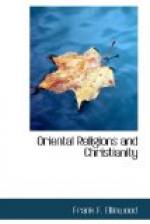In the brief time allotted me, I can only call attention to a few salient points of a general character. In the outset, a distinction should be drawn between Buddhist history and Buddhist legend, for just at this point the danger of misrepresentation lies. It is true that the Buddha lived before the time of Christ, and therefore anything of the nature of real biography must be of an earlier date than the teachings of Jesus; but whether the legends antedate His life and doctrines is quite another question. The Buddhist apologists all assume that they do, and it is upon the legends that most of the alleged parallelisms in the two records are based. How, then, shall we draw the line between history and legend? The concensus of the best scholarship accepts those traditions in which the northern and southern Buddhist records agree, which the Council of Patna, B.C. 242, adopted as canonical, and which are in themselves credible and consistent with the teachings of Gautama himself. According to this standard of authority Gautama was born about the sixth century B.C., as the son and heir of a rajah of the Sakya tribe of Aryans, living about eighty miles north by northwest of Benares. His mother, the principal wife of Kajah Suddhodana, had lived many years without offspring, and she died not long after the birth of this her only son, Siddartha. In his youth he was married and surrounded by all the allurements and pleasures of an Oriental court. He, too, appears to have remained without an heir till he was twenty-nine years of age, when, upon the birth of a son, certain morbid tendencies came to a climax, and he left his palace secretly and sought true comfort in a life of asceticism. For six years he tried diligently the resources of Hindu self-mortification, but becoming exhausted by his austerities, almost unto death, he abandoned that mode of life, having apparently become atheistic. He renounced the idea of merit-making as a means of spiritual attainment, and he was sorely tempted, no doubt, to return to his former life of ease. But he withstood the temptation and resolved to forego




